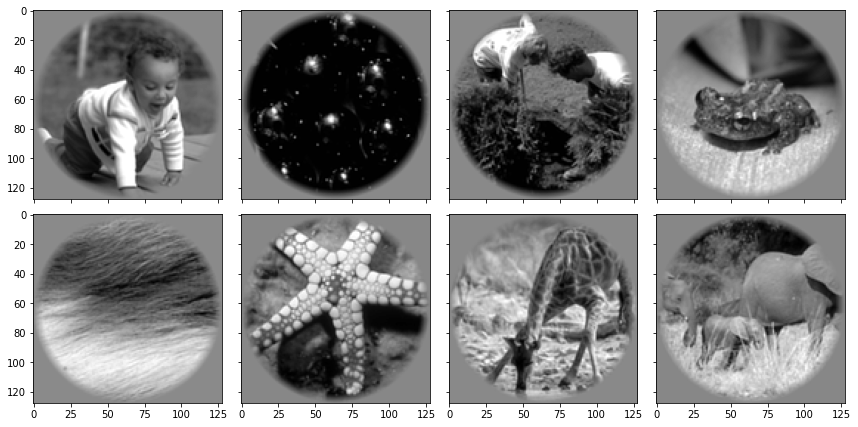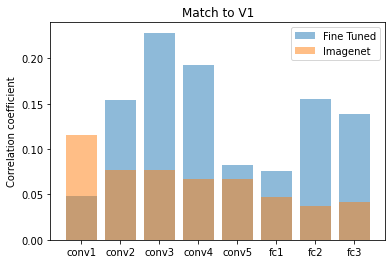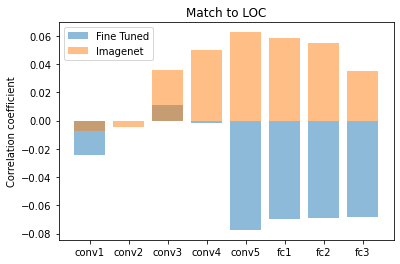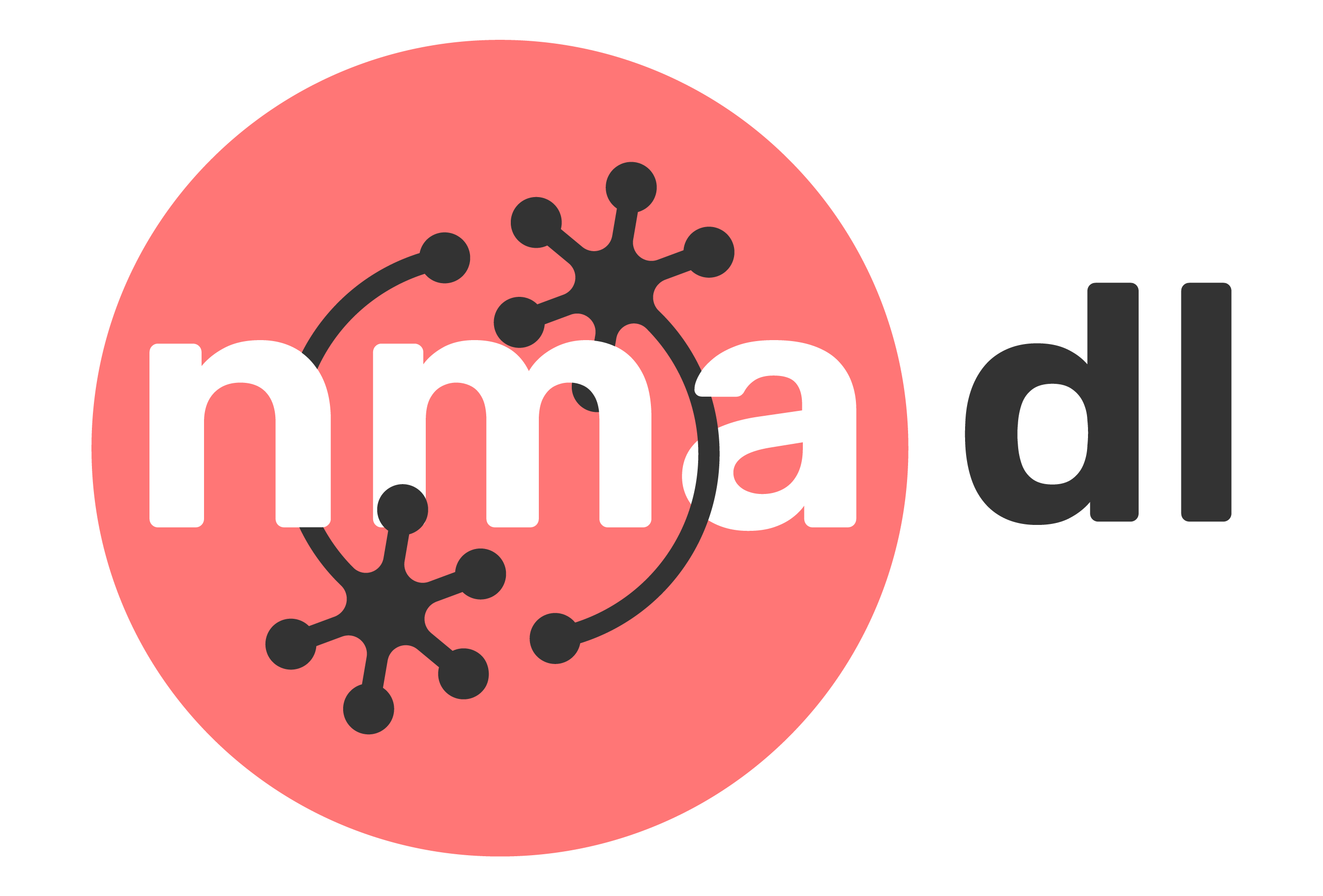Moving beyond Labels: Finetuning CNNs on BOLD response#
By Neuromatch Academy
Content creators: Aakash Agrawal
Production editors: Spiros Chavlis
Finetuning CNN using regression loss#
CNN are proven to be a better model of visual cortex, but the goal of visual cortex is not limited to image classification.
Typically, to model visual cortex responses using CNNs, we -
Extract features of intermediate layers
Reduce dimensionality of the data using techniques like PCA
Perform regression to predict neural data.
This approach fails to predict all the variance in the data.
A better approach is to train CNNs directly on the neural response.
Setup#
Install dependencies#
Show code cell source
# @title Install dependencies
!pip install Pillow --quiet
!pip install torch_intermediate_layer_getter --quiet
Building wheel for torch-intermediate-layer-getter (setup.py) ... ?25l?25hdone
# Imports
import copy
import numpy as np
import matplotlib.pyplot as plt
from PIL import Image
import torch
from torch import nn, optim
from torch.utils.data import Dataset
from torch_intermediate_layer_getter import IntermediateLayerGetter as MidGetter
from torchvision import transforms
import torchvision.models as models
from scipy.spatial.distance import pdist
from scipy.stats import pearsonr
Downloading Kay dataset#
Show code cell source
# @title Downloading Kay dataset
import requests
fnames = ["kay_labels.npy", "kay_labels_val.npy", "kay_images.npz"]
urls =['https://osf.io/r638s/download',
'https://osf.io/yqb3e/download',
'https://osf.io/ymnjv/download']
for i, url in enumerate(urls):
r = requests.get(url, allow_redirects=True)
with open(fnames[i], 'wb') as fh:
fh.write(r.content)
with np.load(fnames[2]) as dobj:
dat = dict(**dobj)
labels = np.load('kay_labels.npy')
val_labels = np.load('kay_labels_val.npy')
Visualizing example images#
Show code cell source
# @title Visualizing example images
f, axs = plt.subplots(2, 4, figsize=(12, 6), sharex=True, sharey=True)
for ax, im in zip(axs.flat, dat["stimuli"]):
ax.imshow(im, cmap="gray")
f.tight_layout()
plt.show()

Dataset Structure#
dat has the following fields:
stimuli: stim \(x_i \, \, x_j\) array of grayscale stimulus imagesstimuli_test: stim \(x_i \, \, x_j\) array of grayscale stimulus images in the test setresponses: stim \(x\) voxel array of \(z\)-scored BOLD response amplituderesponses_test: stim \(x\) voxel array of \(z\)-scored BOLD response amplitude in the test setroi: array of voxel labelsroi_names: array of names corresponding to voxel labels
# Converting stimulus to RGB and changing the scale to 0-255 (Specific to Kay dataset images)
stimuli_tr = dat["stimuli"]
stimuli_ts = dat["stimuli_test"]
stimuli_tr_xformed = np.zeros((1750, 3, 128, 128))
stimuli_ts_xformed = np.zeros((120, 3, 128, 128))
for i in range(1750):
img = stimuli_tr[i, :, :]
img = ((img - np.min(img))*255/(np.max(img) - np.min(img))).astype(int)
stimuli_tr_xformed[i, :, :, :] = [img,img,img]
for i in range(120):
img = stimuli_ts[i, :, :]
img = ((img - np.min(img))*255/(np.max(img) - np.min(img))).astype(int)
stimuli_ts_xformed[i, :, :, :] = [img, img, img]
Fine Tuning AlexNet on voxel activations#
Setting up training and test data for LOC region#
Show code cell source
# @title Setting up training and test data for LOC region
loc_id = np.where(dat['roi'] == 7)
response_tr = np.squeeze(dat["responses"][:, loc_id])
response_ts = np.squeeze(dat["responses_test"][:, loc_id])
Custom dataloader for loading images in numpy array#
Show code cell source
# @title Custom dataloader for loading images in numpy array
class MyDataset(Dataset):
def __init__(self, data, targets, transform=None):
self.data = data
self.targets = torch.LongTensor(targets)
self.transform = transform
def __getitem__(self, index):
x = self.data[index]
y = self.targets[index]
if self.transform:
x = Image.fromarray(self.data[index].astype(np.uint8).transpose(1, 2, 0))
x = self.transform(x)
return x, y
def __len__(self):
return len(self.data)
transform = {
'train': transforms.Compose([
transforms.RandomResizedCrop(224),
transforms.RandomHorizontalFlip(),
transforms.ToTensor(),
transforms.Normalize([0.485, 0.456, 0.406],
[0.229, 0.224, 0.225])
]),
'val': transforms.Compose([
transforms.Resize(256),
transforms.CenterCrop(224),
transforms.ToTensor(),
transforms.Normalize([0.485, 0.456, 0.406],
[0.229, 0.224, 0.225])
]),
}
dataset = {}
dataset['train'] = MyDataset(list(stimuli_tr_xformed),
list(response_tr), transform=transform['train'])
dataset['val'] = MyDataset(list(stimuli_ts_xformed),
list(response_ts), transform=transform['val'])
dataset_sizes = {x: len(dataset[x]) for x in ['train', 'val']}
dataloaders = {x: torch.utils.data.DataLoader(dataset[x], batch_size=50) for x in ['train', 'val']}
device = torch.device("cuda:0" if torch.cuda.is_available() else "cpu")
# Training
net = models.alexnet(pretrained=True)
num_ftrs = net.classifier[6].in_features
net.classifier[6] = nn.Linear(num_ftrs, np.shape(response_ts)[1])
net.to(device)
criterion = nn.MSELoss()
learning_rate = 0.1 # Change this
num_epochs = 5 # Change this
optimizer = optim.SGD(net.parameters(), lr=learning_rate, momentum=0.9)
best_model_wts = copy.deepcopy(net.state_dict())
best_loss = 10.0
for epoch in range(num_epochs):
print(f"Epoch {epoch}/{num_epochs - 1}")
print('-' * 20)
# Each epoch has a training and validation phase
for phase in ['train', 'val']:
if phase == 'train':
net.train() # Set model to training mode
else:
net.eval() # Set model to evaluate mode
running_loss = 0.0
running_corrects = 0
# Iterate over data.
for inputs, labels in dataloaders[phase]:
inputs = inputs.to(device)
labels = labels.to(device)
# zero the parameter gradients
optimizer.zero_grad()
# forward
# track history if only in train
with torch.set_grad_enabled(phase == 'train'):
outputs = net(inputs)
loss = criterion(outputs.float(), labels.float())
# backward + optimize only if in training phase
if phase == 'train':
loss.backward()
optimizer.step()
# statistics
running_loss += loss.item() * inputs.size(0)
epoch_loss = running_loss / dataset_sizes[phase]
print(f"{phase} Loss: {epoch_loss:.4f}")
# deep copy the model
if phase == 'val' and epoch_loss < best_loss:
best_loss = epoch_loss
best_model_wts = copy.deepcopy(net.state_dict())
print()
# load best model weights
net.load_state_dict(best_model_wts)
Epoch 0/4
--------------------
train Loss: 0.4805
val Loss: 0.0503
Epoch 1/4
--------------------
train Loss: 0.4680
val Loss: 0.0503
Epoch 2/4
--------------------
train Loss: 0.4679
val Loss: 0.0501
Epoch 3/4
--------------------
train Loss: 0.4677
val Loss: 0.0500
Epoch 4/4
--------------------
train Loss: 0.4677
val Loss: 0.0499
<All keys matched successfully>
## Extract features of all the intermediate layers from ImageNet-trained and finetuned Alexnet
return_layers = {
'features.2': 'conv1',
'features.5': 'conv2',
'features.7': 'conv3',
'features.9': 'conv4',
'features.12': 'conv5',
'classifier.1': 'fc1',
'classifier.4': 'fc2',
'classifier.6': 'fc3',
}
# Loading AlexNet pretrained on Imagenet
net_im = models.alexnet(pretrained=True)
net_im.eval()
net_im.to(device)
# Setting up feature extraction step
midfeat_ft = MidGetter(net, return_layers=return_layers, keep_output=True)
midfeat_im = MidGetter(net_im, return_layers=return_layers, keep_output=True)
# Loading validation data and forward pass through the network
dataloaders = {x: torch.utils.data.DataLoader(dataset[x], batch_size=120) for x in ['val']}
for inputs, labels in dataloaders['val']:
inputs = inputs.to(device)
mid_outputs_ft, _ = midfeat_ft(inputs)
mid_outputs_im, _ = midfeat_im(inputs)
Dissimilarity - Correlation#
Show code cell source
# @title Dissimilarity - Correlation
# Loading V1 and LOC responses
v1_id = np.where(dat['roi'] == 1)
loc_id = np.where(dat['roi'] == 7)
Rts_v1 = np.squeeze(dat["responses_test"][:, v1_id])
Rts_lo = np.squeeze(dat["responses_test"][:, loc_id])
# Observed dissimilarity - Correlation
fMRI_dist_metric_ft = "euclidean" # ['correlation', 'euclidean']
fMRI_dist_metric_im = "correlation" # ['correlation', 'euclidean']
Alexnet_ft_dist_metric = "euclidean" # ['correlation', 'euclidean']
Alexnet_im_dist_metric = "correlation" # ['correlation', 'euclidean']
dobs_v1_ft = pdist(Rts_v1, fMRI_dist_metric_ft)
dobs_lo_ft = pdist(Rts_lo, fMRI_dist_metric_ft)
dobs_v1_im = pdist(Rts_v1, fMRI_dist_metric_im)
dobs_lo_im = pdist(Rts_lo, fMRI_dist_metric_im)
# Comparing representation of V1 and LOC across different layers of Alexnet
r, p = np.zeros((4, 8)), np.zeros((4, 8))
for i,l in enumerate(mid_outputs_ft.keys()):
dnet_ft = pdist(torch.flatten(mid_outputs_ft[l], 1, -1).cpu().detach().numpy(),
Alexnet_ft_dist_metric)
dnet_im = pdist(torch.flatten(mid_outputs_im[l], 1, -1).cpu().detach().numpy(),
Alexnet_im_dist_metric)
r[0, i], p[0, i] = pearsonr(dnet_ft, dobs_v1_ft)
r[1, i], p[1, i] = pearsonr(dnet_im, dobs_v1_im)
r[2, i], p[2, i] = pearsonr(dnet_ft, dobs_lo_ft)
r[3, i], p[3, i] = pearsonr(dnet_im, dobs_lo_im)
Plotting correlation between observed and predicted dissimilarity values#
Show code cell source
# @title Plotting correlation between observed and predicted dissimilarity values
plt.bar(range(8), r[0, :], alpha=0.5)
plt.bar(range(8), r[1, :], alpha=0.5)
plt.legend(['Fine Tuned', 'Imagenet'])
plt.ylabel('Correlation coefficient')
plt.title('Match to V1')
plt.xticks(range(8), mid_outputs_ft.keys())
plt.show()
plt.figure()
plt.bar(range(8), r[2, :], alpha=0.5)
plt.bar(range(8), r[3, :], alpha=0.5)
plt.legend(['Fine Tuned', 'Imagenet'])
plt.ylabel('Correlation coefficient')
plt.title('Match to LOC')
plt.xticks(range(8), mid_outputs_ft.keys())
plt.show()



